|
Muzzle Blasts Online |
|
...for the muzzleloading enthusiast |
|
The muzzleblasts.com domain, subdomains, content, etc., are neither affiliated with the NMLRA nor its paper magazine Muzzle Blasts |
|
Muzzle Blasts Online |
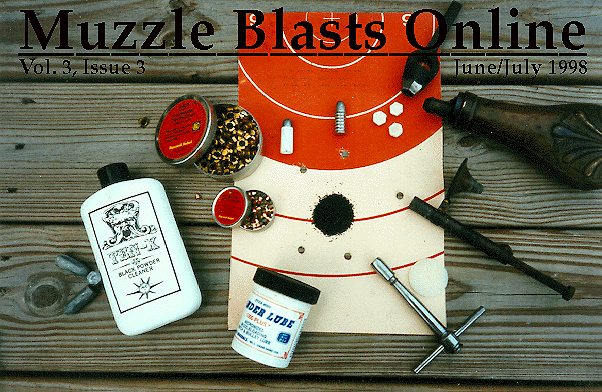
|
|
|
|
|
|
Eagles and Other Rare Birds
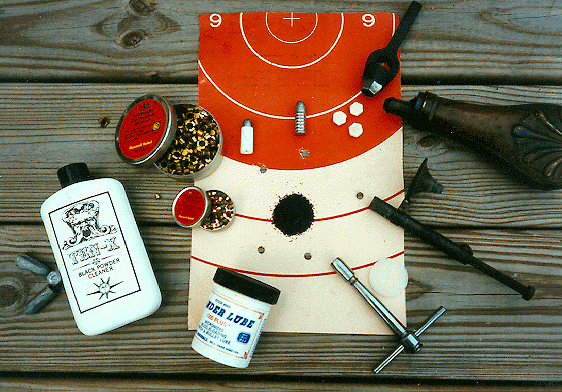
|
|
Typical clutter of equipment used by long-range shooters. These are for a Whitworth |
One of the reasons that these matches are a bit unusual is the fact that rifles which can be used in them are not at all common. Indeed, I have skidded to a stop more than once to see some of the museum-quality rifles that appear at our shoot.
Let's take a look at what it might be like to participate in a long-range match at Friendship.
You load your muzzleloading rifle and approach the firing line. You carefully assess the conditions as you lower your body into a supine position. You note that the powder smoke from the firing line to your right is being carried toward a point just in front of you, meaning that the wind is coming from four o'clock.
Looking down range you note that an unmowed tuft of meadow grass near your target is bending from left to right. A quick check with your spotter, behind a 25-power telescope, confirms the fact.
What to do? The target is over 500 yards away. The wind at the firing line and the wind at the targets are blowing in nearly opposite directions. Not only does this represent a change in conditions, but your spotter, who has been keeping watch while you have been loading, reports that the present condition seems to be holding steadily. Your spotter also reminds you that there is only about a minute, if that, left in the relay. What to do? Where to hold?
The prevailing condition before that had been a wind solidly from left to right. Your sights are set for that condition--about six minutes of left windage worth! The last hit was somewhat left of center and a bit high. But it was a solid hit. Your mental computer kicks in and has you remove the left windage from your sight and enter three minutes of right windage. You also give your rear sight two minutes of "down" elevation.
You wiggle into position quickly; the shot breaks cleanly, and after an interval of apprehension while the bullet trundles its way 500 yards down range, the spotter announces a solid hit. This is confirmed, after a similar delay, by the unmistakable sound of the strike itself finally reaching your ear. The sound of the bullet strike is traveling back to you at about the same speed as the average speed of the bullet. You hear it dimly but unmistakably through your ear protection some three seconds after the bullet leaves your rifle! Sweet music!
As you relax and start to rise, the range officer calls out: "Cease fire on the bench, chunk, silhouette, and slug gun lines". You can be proud that you figured out the right thing to do and did it in time to complete the match before the end of the relay.
No ordinary muzzleloading shooting this! Although there is nothing new in shooting at distances over 500 yards with a muzzleloader, it is not something that many muzzleloading shooters understand. Elongated bullets are king in this competition. Roundballs you can fire from the shoulder are, arguably, not too reliable at distances of 200 yards and over. That's particularly true under the above-illustrated changing conditions.
Part of the popular Silhouette Range at Friendship is set aside for long-range silhouette shooting. There are metallic silhouettes in the NRA format, set up as swingers at the following distances: chicken at 200 meters, pig at 300 meters, turkey at 385 meters, and ram at over 500 yards. There are different matches at long range silhouettes that cater to differing interests and kinds of equipment.
There are matches for the traditional long-range rifles. These are not to weigh more than ten pounds, and they have a minimum three-pound trigger pull (no set triggers). The rifles used in this specific match are expected to have traditional styling and to have traditionally-styled metallic sights (no click adjustments, etc). There are other matches for traditionally-styled rifles having set triggers and no weight limit. There is yet another match for the straight-line rifles becoming so popular with muzzleloading hunters.
While others had much to do with the development of elongated bullets in muzzleloading rifles, perhaps none had more influence than Sir Joseph Whitworth. It was he who scientifically investigated rifle making at the request of the British government. This was well over one hundred years ago. The culmination of his efforts was the famous hexagonal rifling system which bears his name. He was perhaps best known in the US for the Whitworth long-range rifles used with such telling effect in the American Civil War.
The names of Gibbs (rifle maker), Metford (tireless shooter and experimenter), John Rigby (rifle maker and International Team shooter--Irish, of course!), Alexander Henry, and many other Englishmen are closely associated with long-range shooting. There were a number of long-range rifle makers in the US also. Many Civil War students are aware that the US Berdan Sharpshooters used a heavy telescope-mounted rifle in siege work. They used the Colt revolving rifle and the Sharps rifle in skirmish work.
The matches talked about here are, as mentioned, relatively unusual in the U.S. On the other side of the equator there is much more activity in the long-range arena. South Africa, New Zealand, and Australia have had such matches for a number of years.
What is called long-range at Friendship is, in reality, mid-range to the practitioners of really long-range shooting (1000 yards or perhaps more). However, this is the longest range we can utilize practically. The long-range matches at Friendship are a celebration of what was, arguably, the highest development of the muzzleloading rifle. The other group who can, in the writer's opinion, lay claim to this honor, is the one described below.
Elsewhere on the grounds at Friendship, Indiana, and not far away, there is a Schuetzen range. The rifles used in Schuetzen shooting are not the same as the long-range rifles listed above, although there are striking similarities, and differences, too! While there is a "free-rifle" match at Friendship, it calls for a roundball. Said match is at fifty yards. We are not talking about that match here. A Schuetzen-styled rifle can be used in the free-rifle match, but in this article we are talking about matches at 100 and 200 yards. The roundball is clearly outclassed here. See details of the Eagle Match below.
It is in the utilization of an elongated bullet and fast twist rifling to stabilize it that the greatest similarity with long-range shooting exists. Since the Schuetzen targets are posted at 100 and 200 yards, smaller calibers are used. Instead of the typical .45 caliber bullet used at long-range silhouette, the typical Schuetzen shooter uses a .38 caliber bullet. Few rifles are larger than .40 caliber. Instead of a bullet weighing 450 to 540 grains, the Schuetzen shooter uses one weighing about half that--perhaps 250 or 300 grains. Consider the above in the light of the fact that a 50-caliber roundball weighs about 180 grains.
While paper-patched bullets are used in the rifles of the Schuetzen shooters and the long-range silhouette shooters, the grooved, lubricated bullet gets a good workout. This is undoubtedly due to grooved bullets being easier to make at an accuracy level very nearly the same as the paper-patched bullets. Many shooters feel that the paper-patched bullet is the more accurate of the two. Again, in my opinion, any accuracy difference is well hidden by an important accuracy limitation, namely the shooter.
Powder charges are modest in both long-range silhouette and Schuetzen shooting--perhaps 55 grains at Schuetzen and 70 grains at long-range. In spite of this, recoil with the heavier bullets is a telling factor over the length of the shoot. Padding for the shoulder is definitely recommended in long-range shooting and should be considered also by the Schuetzen shooter.
Schuetzen shooting is a study in careful offhand holding and wind doping. Unlike the long-range silhouette matches, the Schuetzen shooter does not usually utilize a spotter. At long-range silhouette, a spotter is mandatory to do the scoring. In addition, the spotter may offer coaching and information on wind and light changes, as well as remind the shooter of elapsed time. While a spotter/coach is legal in Schuetzen shooting, most shooters do without.

|
|
Schuetzen shooters at Friendship |
At the same time they are chaffing each other, competitors will quietly--and sometimes not so quietly--help each other where needed.
While period dress is definitely not required, it is welcomed where the shooter cares to display it. This is especially true at special events like the King's match on the last Saturday of the National Shoot. The Eagle Match is also a special event. Both are Schuetzen matches and require traditional match rifles and ammunition. Both are for Schuetzen rifles, but the bullets used are vastly different.
The traditional Schuetzen rifle, the traditional long-range rifle, and the more modern-looking straight-line rifle are very different from one another in appearance. Each has its following, and the NMLRA makes all three types welcome. It is true that many of those favoring one style have little use for the other/s. There is room for all, and it is often interesting to see the relative types contested side by side, even though they may be in different matches.
The writer favors the traditional rifles, finding it great sport to defeat (when he can!) those who suppose that the more modern-looking rifles have some advantage. He will concede, however, that click-adjustable sights are a distinct advantage over the traditional sights, as is the telescope. Click-adjustable sights are tolerated on the traditional Schuetzen rifles until the owner can get the proper traditional sighting equipment installed. It is simply not a level playing field when one shooter can quickly click over for a change in wind--without taking his or her eyes off the wind flags--while the traditional shooter must deal with a magnifying glass and perhaps a hammer to make a windage correction.
During the 1998 shooting season, there will be increased emphasis on accommodating the newer styles of rifles using sabots, jacketed bullets, and whatever else is loaded from the muzzle.
To those who think they might be interested in the shooting mentioned here, the following is offered. Please keep in mind that opinions abound on this as well as other subjects. There are other thoughts and methods, but the following will suffice to indicate differences from the better-known roundball shooting.
The main differences that set the two kinds of Schuetzen rifles apart from long-range rifles are weight and stock configuration. As mentioned, the long-range rifles under the old international rules had to weigh less than ten pounds. In some matches at Friendship, greater weight is allowed. The only constraint in the Schuetzen rifle is the weight that the shooter can comfortably support. Many run from twelve to fourteen pounds; some weigh less.
As to stock configuration, the Schuetzen rifle stocks were designed to be comfortable in the standing position. These feature, for the most part, a great deal of drop at the heel of the stock. If this same stock is tried in the prone position, it is likely that the toe of the stock will touch the ground (against the rules in many places). Assuming that this part does work out alright, your neck will be bent back at a severe angle. Not good!
On the other hand, long-range rifle stocks are very straight. Many long-range stocks have the same drop at the heel that they do at the comb, neither one being very great. A delightful side effect of the straight stock is a lessening of apparent recoil. This is due to the fact that a greater amount of the actual recoil moment is directed to the shoulder, and not to the cheek and/or nose of the shooter. The recoil is still there, it's just that your shoulder is better able to absorb it than your nose!
Some shooters shoot the long-range rifles from the back position. That is to say that the shooters lie on their backs to do this. This is likely the steadiest position that uses body support alone. Not many Friendship shooters do this. The more common face-forward/down position is favored. A straight stock configuration is usually better in the back position, and usually necessary in the latter.
External configuration and weight issues aside, the technical difference that sets the elongated-bullet rifle apart from the roundball rifle is the rifling twist. Roundball rifles typically have a twist rate of one turn in four to six feet. This is more than sufficient to stabilize round balls of the sizes we are accustomed to shooting. An elongated bullet in the sizes of interest here would tumble end-for-end and fly wild from such a slow twist.
The long-range rifles are generally of .40 to .45 caliber. Twist rates of from as fast as one turn in 17 inches to one turn in 22 inches are generally recommended. A 25-inch twist can work, but only with the lighter-weight bullets in .45 caliber. The spin of the bullet causes it to fly point foremost through the air. Longer bullets require faster spin to do this. Twists faster than necessary create more drift, and many feel that bullets fired from such barrels are more sensitive to wind drift.
Longer bullets also resist acceleration in the barrel due to the fact that there is more weight to accelerate within the same bore area. All the barrel has to work with is pressure on the base area of a bullet. In fact, elongated bullets develop little more than half the velocity of a roundball under similar circumstances. It is fairly obvious that a slower bullet will twist more slowly in the same barrel. Assuming that you have a two-foot twist instead of a four-foot twist, you can see that the spin will be roughly the same if the speed is half that of the four-foot twist. In order to get more spin, a faster twist than two feet is needed. Hence the numbers given above.
Even as the elongated bullet is slower to put into motion as seen above, it is also slower to give up its velocity to air resistance. This is the secret of its long-range success. It has greater inertia than a roundball of the same diameter. It is this feature that gives it superiority to the roundball in energy retention, trajectory flatness, and wind drift at the longer ranges.
For Schuetzen rifles of .38 caliber, the twist should be about one turn in 16 to 18 inches. I have a rifle with an 18-inch twist that will stabilize a 326 grain (that's heavy!) bullet at certain times of the day, but not at other times! After I changed to a 250-grain bullet (quite a bit shorter), all that nonsense stopped! The critical issue here is actually the length of the bullet, not the weight. It will be seen, however, that a heavier bullet tends to be longer. A bullet with a long, skinny nose configuration can put you into trouble as quickly as an extra twenty or so grains of weight.
In Schuetzen shooting at 200 yards, arguably the most fun is had at the painted target. This is a special stand-alone match. It is usually contested for on the last Saturday afternoon of the National Championship Shoot, after the rest of the shooting has ended for the day. Last year's winner brings forth a painted target about two feet in diameter (although there are no hard and fast rules on this). Painted on the surface of the target is whatever the donor is moved to produce. He or she may do this themselves or have it done. When it was Mike Yazel's turn to supply the target, he produced one hand carved in relief in solid wood! You can see this one as well as all others in our museum.
The target is placed at 200 yards and the contestants are made up of those who competed in the Schuetzen aggregate. Each is allowed to take one shot at the target--no sighters allowed; cold turkey! He or she who gets closest to the place designated by the maker is the Koenig, or king, for the year. As mentioned, he or she then has the honor of providing the target for the next year. The targets are then retired to the museum.
The last special event we will consider here is the Eagle Match. This, like the match above, has its origin in continental Europe. In this competition, an effigy eagle is put together by last year's winner. It is typically made of wood and is of a more-or-less uniform design. The target eagle is placed at around 40 meters from the firing line, this depending upon the weather, the light conditions, the size of the eagle, and the whim of the Schuetzen Meister.
In this competition, shooters "buy" a shot by paying one dollar to the Schuetzen Meister and placing their name on a roster in the sequence they want. As their names come up, they shoot at specific designated parts of the eagle. Those who hit and knock off the designated pieces win premiums. When the premiums are exhausted, or at the whim of the Schuetzen Meister the shooters start to shoot at the last piece. The shooter who downs it wins the remainder of the pot--and the honor of supplying the target for next year!
This competition is conducted in a manner similar to the painted target match: after the competition for the day, usually a Saturday, on the main range. Unlike the painted target, which ends up in our museum with autographed holes, the eagle is literally shot to pieces!
If you have seen rifles from Europe looking like the Schuetzen rifle mentioned earlier, only having a very large bore with a twist rate suited to the round-ball, you've found the ideal rifle for Eagle competition. The big roundball pushed by a low to medium charge of powder can be very accurate and is calculated to make the splinters fly and carry away pieces of the wood! More speed is not necessarily better!
In response to an earlier article in Muzzle Blasts on the topic of Schuetzen shooting, Philip Sauerlender, of State College, Pennsylvania, kindly sent us a letter outlining what he found concerning Schuetzen shooting on a visit to Germany:
Editor: May 14, 1996
I have been reading the articles by Tom Schiffer on Schuetzen shooting with a great deal of interest. I spent a week in the town of Attendorn just prior to Easter this year and thought you might be interested in what I found about the local Schuetzenfests there.
Attendorn is an old medieval trading city of about 30,000 located in the Sauerland. It is about an hour east of Cologne and an hour south of the steel and coal complexes along the Ruhr. The Sauerland is a mountainous area looking a bit like parts of Pennsylvania. Half of it is pine forests, but it has lots of towns with metal working industries of various kinds. Our family left in 1835 to live in Jamaica, B. W. I., where my father was born. There is a lively bed-and-breakfast industry in the Sauerland, but it is primarily for Germans getting away from the cities. An American is very rare, and finding anything in English is very difficult. I ended up doing a lot of pointing!
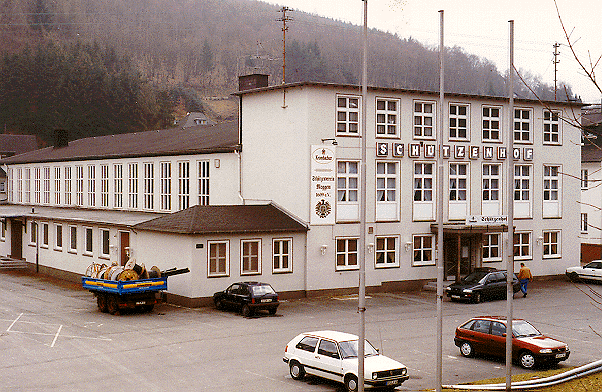
|
|
Shooting house in Sauerland. There is one in every town |
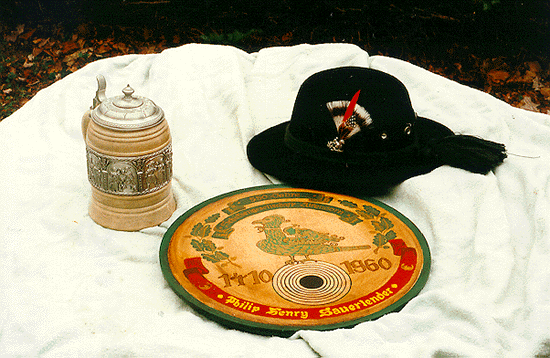
|
|
Sauerland shooting artifacts |
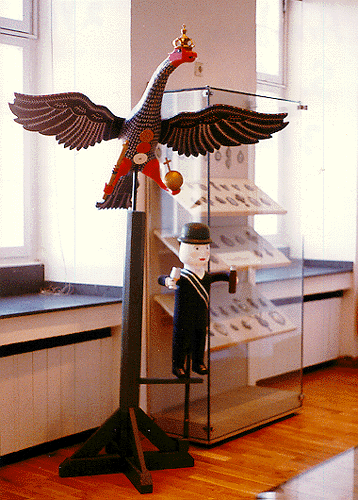
|
|
Eagle such as is used in Sauerland competition |
I have enclosed for your use copies of the pictures I took. The modern Schuetzenhalle in Eslohe is particularly interesting. There is a large mural to one side which shows many interesting details of the flags, targets, patron saints, etc. I saw signs suggesting that these halls were being used as general purpose sports auditoriums, but it was clear that shooting was the main emphasis. Another picture I have shows Dieter Weiss painting my name on the Schuetzen Scheibe. In Finnentrop I found a target box on the hillside. Mr. Weiss said that the bird target is mounted inside and is hoisted up in the air to be shot at. The back of the box was lined with foam board and the holes were approximately a half-inch in diameter. If you look carefully, there is an Easter Cross on the background. This will be set on fire Easter evening. Finally I took pictures in the Sauerland museum in Arnsberg and the Burg (castle) Altena. Both had interesting Schuetzen club exhibits. The pamphlet is from the Schuetzen club museum in Attendorn (unfortunately closed for the season). It is located in one of the two remaining Medieval wall towers.
Best wishes
Philip Sauerlender
Member # 47234
My sincere thanks to Philip for sharing his experience and his photographs with us.
If you are interested in shooting in a match similar to the ones mentioned above, the Koenig and Eagle matches shot during the National Championship at Friendship, Indiana, are for you. This year we will hold the Koenig match on Saturday, June 20, 1998. The Eagle match will be held on Saturday, June 13, 1998. Check the program for details. Also note that the weather has sometimes caused us to reschedule these matches without prior notice. Bear with us.